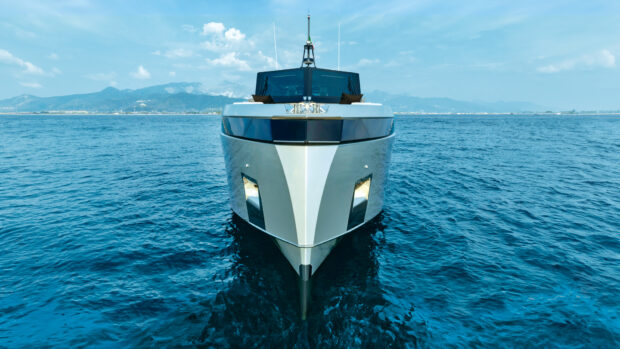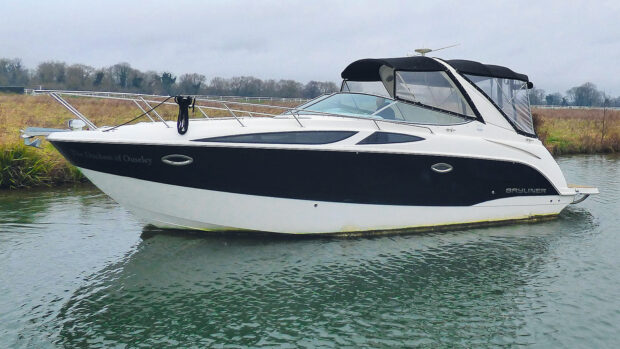The May 1987 issue of MBY contains an unusual boat report.
The May 1987 issue of MBY contains an unusual boat report. It is rare for MBY to be able to try out two versions of the same craft with different engines, but in the case of the Windy 9800 we had a choice of either petrol or diesel power for the test. Great, we said, we’ll take both.
The 9800 appeared in the UK at the 1987 London boat show. At that stage it was the largest Windy yet produced. Very much a fun-in-the-sun boat, the helm and cockpit took up more than half the length of the hull Windy were one of the pioneers of the open-cockpit cruiser, which is ironic considering that they are further from the Mediterranean than almost any other European boatbuilder.
Windy Boats were founded in 1966 in Arendal, southern Norway, by Hugo Vold, the son of a local fisherman. (He called the company Windy, incidentally, after the name of his father’s boat.) Arendal is a town with both feet firmly in the water and many families own a boat. As owners and users themselves, the Windy workforce therefore have more than a passing interest in the boats they build, ensuring high standards.
Simon Purser bought Impulse in 1990, at the very end of its production run: indeed, importer Andrew Constance had to find him an ex-demonstrator model in a Norwegian dealership as the factory had already ceased production. He had previously owned a Windy 23FC weekender which, like Impulse, he kept at Topsham on the River Exe. A sailor by inclination, he had taken up motorboating more for reasons of practicality than anything else. Living in London during the week, but returning to Devon most weekends, he needed to be sure of getting back to Topsham in time to return to London on Sunday night. For this, horsepower proved altogether more reliable than wind power.
He was surprised to find how much he enjoyed motorboating, and when in 1989 he moved back to Devon full time, he started looking around for a larger craft. The 9800 fitted the bill. Having a cockpit that takes up so much of the boat inevitably means some compromises have to be made in the accommodation, so the 9800’s nominal capacity of four adults sleep on a vee-berth, which fills the main saloon, and in a mid-cabin extending under the helm, with headroom limited to a small area by the door of the cabin. For two, however Simon has no children the accommodation is generous.
One of the neatest aspects of the interior layout is the galley, which is situated at the foot of the companionway leading from the cockpit. Instead of a narrow hatch at the top of the steps, the opening is a full metre wide, providing unlimited ventilation over the cooking area.
The standard cooker is a paraffin-burning, two-ring hob made by Wallas Marin. This is one of the 9800’s few failings: after years of battling with ignition problems, Simon has given up trying to use the cooker altogether. For hot drinks he has a 12V DC kettle which plugs into a socket in the cockpit, and for hot meals he prefers to eat ashore.
The engines are US-made Volvo 211hp AQ211s. At Simon’s preferred cruising revs of 3,100rpm, these deliver 29 knots on a flat sea. In our May 1987 test, a twin 180hp BMW diesel-powered 9800 achieved 34 knots, while the petrol-engined version with 260hp hit 41 knots, so Impulse has a lot in reserve. Interestingly, she performs better on full tanks, despite the extra weight. The downside is, of course, fuel consumption: even at the reduced revs the 5lt V8s drink petrol at a rate of 15-20gph. This can present logistical difficulties, especially in the West Country where waterside petrol can be hard to come by.
One of the other drawbacks with petrol engines on boats is that they can be difficult to start. This was the case with Impulse as the distributors, located right at the back of the engines near the transom, tended to become damp when the wind was blowing upriver. Fitting a proprietary electronic ignition system, at a cost of about £300 per engine, has gone a long way towards resolving the problem. The only other unexpected engine expense was a valve which ‘tuliped’ and had to be replaced.
Impulse is kept on a swinging mooring opposite Topsham Quay, which could hardly be more convenient. Not only does Simon live in the village, but he also has an interest in an antiques warehouse on the quay itself, so at the end of the season the Windy can be hauled out, blocked off and left in the car-park for the winter.
When cruising, Simon tends to go west. “It’s a long haul across Lyme Bay to Portland Bill, and there’s little there,” he says (an assertion that readers in Dorset might take issue with). Similarly, he would rather not run the risk of being weatherbound in France or the Channel Islands. He usually joins the Windy Owners’ Club cruises, and has taken the boat as far as Helford.
Inside and out, the 9800 boasts a wealth of teak. When not in use, Impulse is covered. Simon also oils the teak regularly, maintains a good covering of varnish on the taffrail and steps, which come in for rather harder wear, and keeps the inside fresh over the winter with dehumidifier crystals. As a result of these simple precautions, Impulse is in very good condition for an eight-year-old craft.
Now that Windy build boats up to 43ft (13.1m), will Simon be changing the boat? It’s unlikely, was the response. Impulse still meets all his needs, and besides, if he were to go larger, he’d have to find another mooring further downstream. You might say he’d no longer be able to go boating on impulse.
Windy Owners’ Club
One of the more active owners’ clubs, the Windy Owners’ Club, was formed some nine years ago and enjoys a good deal of support both from Windy in Norway and from UK importers Express Cruisers. Its main activity is organising cruises in company, most starting from Lymington and heading south across the Channel, or west to Dorset and Devon. The club publishes a newsletter, hosts dinner dances combined with trips to the London and Southampton shows, and visits the factory in Norway every other year. Following Windy’s acquisition six years ago by a fellow Norwegian builder, Draco boats are also welcome to join the club.
Further details from Richard Knott, Windy Owners’ Club, 17 Brudenell Avenue, Poole, Dorset BH13 7NW. Tel: 01202 709833. Fax: 01202 701204.
Market report
Windy Boats hold their value well, especially those as well tended as Impulse: she cost £55,000 in 1990, and would fetch around £45,000 today. Diesel versions are 10-15% dearer, with BMW diesels somewhat cheaper. Express Cruisers of Lymington (tel: 01590 6733120) maintain a list of used Windys and Dracos.
DATA
LOA 32ft 2in (9.80m)
Beam 9ft 7in (2.92m)
Draught 2ft 1in (0.61m)
Displacement 3.10 tonnes
Fuel capacity 170gal (750lt)
Water capacity 45gal (200lt)
Accommodation Sleeps four: main cabin
vee-berths; galley; toilet;
mid-cabin below helm
Engines Twin outdrives, diesel or petrol, up to 2 * 311hp
MBY tested May 1997
Built About 300 between 1986
and 1990
Designer Eivind Amble
Manufacturer Windy Boats, Arendal,
Norway









